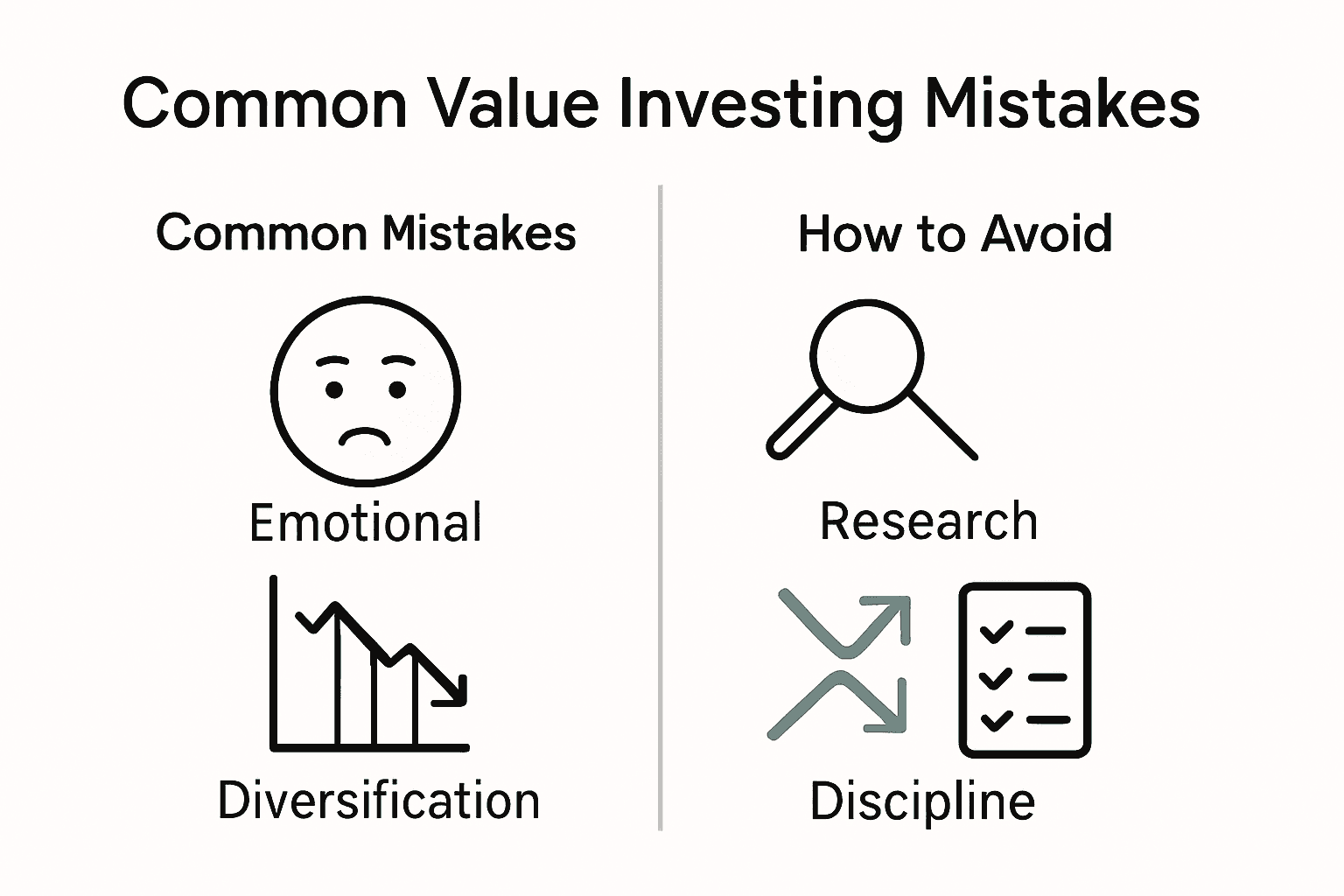More than 80 percent of average investors miss out on long-term gains by chasing market trends rather than solid fundamentals. Value investing flips that approach, allowing disciplined individuals to uncover quality stocks trading at a discount. This method has been used by names like Warren Buffett to achieve consistent success. Understanding value investing helps you spot overlooked opportunities, avoid costly mistakes, and build a resilient portfolio that can weather unpredictable market swings.
Table of Contents
- Defining Value Investing And Core Concepts
- Major Value Investing Strategies Explained
- Key Metrics And Stock Selection Criteria
- Managing Risks In Value Investing Approach
- Common Mistakes And How To Avoid Them
Key Takeaways
| Point | Details |
|---|---|
| Value Investing Fundamentals | This investment strategy focuses on identifying undervalued stocks through thorough fundamental analysis rather than speculation. |
| Key Strategies | Four main strategies include fundamental analysis, quality investing, contrarian investing, and dividend investing for recognizing market inefficiencies. |
| Risk Management Techniques | Diversification and disciplined research are critical for mitigating risks in value investing while maintaining a long-term focus. |
| Common Pitfalls | Investors should avoid emotional decision-making, overconfidence in past performance, and neglecting fundamental research to ensure success. |
Defining Value Investing and Core Concepts
Value investing represents a strategic approach to financial markets where investors seek undervalued stocks trading below their intrinsic worth. According to research from Stanford Graduate School of Business, this investment philosophy bridges academic theory with practical strategies employed by legendary investors like Warren Buffett and Ben Graham.
At its core, value investing is not about speculative trading but fundamental analysis. Investors meticulously examine a company’s underlying financial health, looking beyond short-term market fluctuations to identify stocks priced lower than their genuine economic value. As UC Berkeley research suggests, this approach involves estimating prospective yield by aggregating expected earnings over a comprehensive forecast horizon.
Key principles of value investing include:
- Conducting thorough fundamental research
- Prioritizing long-term investment horizons
- Purchasing stocks below their intrinsic value
- Maintaining a disciplined, patient investment strategy
- Focusing on company fundamentals rather than market sentiment
Successful value investors understand that markets can be emotionally driven, creating opportunities for strategic, rational investors. They view temporary price discrepancies as chances to acquire high-quality assets at discounted rates. While understanding investment portfolio construction can enhance this strategy, the core philosophy remains consistent: buy valuable assets when they are underpriced and hold them until their true value is recognized by the broader market.
Major Value Investing Strategies Explained
Value investing encompasses multiple strategic approaches designed to identify and capitalize on market inefficiencies. According to Forbes, four primary strategies dominate the value investing landscape: fundamental analysis, quality investing, contrarian investing, and dividend investing.
Fundamental Analysis represents the cornerstone of value investing. Investors meticulously examine a company’s financial statements, evaluating metrics like price-to-earnings ratio, debt levels, cash flow, and competitive positioning. This strategy demands deep research and a commitment to understanding a company’s true economic value beyond its current market price.
Contrarian investing emerges as a particularly compelling strategy. As Saxo highlights, market psychology and behavioral biases create unique investment opportunities. Contrarian investors deliberately move against prevailing market sentiment, purchasing stocks that are temporarily undervalued due to negative market perceptions. When exploring the most undervalued stocks in the market, investors can find exceptional opportunities that others might overlook.
The key strategies in value investing include:
- Fundamental Analysis: Rigorous financial statement evaluation
- Quality Investing: Focusing on high-quality companies with strong fundamentals
- Contrarian Investing: Opposing market sentiment strategically
- Dividend Investing: Prioritizing stocks with consistent dividend payments
Successful value investors understand that patience and disciplined research are their greatest tools. They recognize that market inefficiencies create windows of opportunity, and by maintaining a long-term perspective, they can potentially generate substantial returns while managing investment risk.
Key Metrics and Stock Selection Criteria
Value investors rely on specific financial metrics to identify undervalued stocks and make informed investment decisions. According to Forbes, two critical metrics stand out in stock selection: the Price-to-Earnings (PE) ratio and the Price-to-Book (PB) ratio. These indicators help investors assess a company’s true financial health and potential for future growth.
The Price-to-Earnings (PE) ratio provides crucial insights into a stock’s valuation by comparing its current share price to the company’s earnings per share. A lower PE ratio might suggest that a stock is undervalued, indicating potential investment opportunities. MSCI research highlights that value-related variables like earnings-to-price ratios play a significant role in identifying stocks with potential excess returns.
Key metrics for value investing include:
- Price-to-Earnings (PE) Ratio: Comparing stock price to company earnings
- Price-to-Book (PB) Ratio: Assessing a company’s market value relative to its book value
- Debt-to-Equity Ratio: Evaluating a company’s financial leverage
- Free Cash Flow: Measuring a company’s ability to generate cash
- Dividend Yield: Analyzing potential income from stock investments
Investors looking to refine their stock selection process can benefit from learning how to pick stocks through comprehensive analysis. Successful value investing requires a holistic approach, combining these key metrics with thorough research and a deep understanding of a company’s fundamental strengths and potential for long-term growth.


Managing Risks in Value Investing Approach
Value investing inherently requires a strategic approach to managing investment risks. Successful investors understand that minimizing potential downsides is just as critical as identifying promising investment opportunities. While no investment strategy is completely risk-free, value investors can implement several sophisticated techniques to protect their portfolio from potential market volatilities.
Diversification stands as the primary risk management strategy for value investors. By spreading investments across multiple sectors, industries, and companies with different market capitalizations, investors can significantly reduce the impact of any single investment’s poor performance. This approach helps mitigate company-specific and sector-related risks that could potentially derail an investment strategy.
Key risk management techniques in value investing include:
- Conducting thorough fundamental research
- Maintaining a margin of safety
- Implementing strict position sizing
- Regularly rebalancing investment portfolio
- Avoiding emotional decision-making
- Setting clear exit strategies
Investors looking to enhance their risk management skills can benefit from exploring financial risk management strategies that complement value investing principles. Understanding your personal risk tolerance is crucial, as it helps create an investment approach aligned with your financial goals and psychological comfort level. By combining disciplined research, strategic diversification, and a long-term perspective, value investors can effectively navigate market uncertainties while pursuing sustainable investment growth.
Common Mistakes and How to Avoid Them
Value investing requires discipline and strategic thinking, but many investors fall prey to common pitfalls that can significantly undermine their investment success. The most critical mistake is emotional investing – allowing fear, greed, or market hysteria to drive decision-making instead of rational analysis and fundamental research.
One frequent error is overconfidence in past performance. Investors often mistakenly believe that a stock’s historical success guarantees future returns. This thinking leads to overlooking critical changes in a company’s fundamentals, market conditions, or competitive landscape. Successful value investors maintain a skeptical approach, continuously reassessing their investment thesis and being willing to exit positions when underlying conditions change.
Common value investing mistakes include:
- Neglecting thorough fundamental research
- Failing to diversify investments
- Attempting to time the market
- Ignoring company debt levels
- Chasing low-price stocks without quality analysis
- Holding onto losing investments too long
- Lacking a clear investment strategy
Investors seeking to refine their approach can benefit from understanding how to analyze stocks more comprehensively. The key to avoiding these pitfalls lies in maintaining emotional discipline, conducting rigorous research, and developing a systematic approach that prioritizes long-term value creation over short-term market fluctuations. Remember: successful value investing is less about predicting market movements and more about identifying fundamentally strong companies trading below their intrinsic value.


Master Value Investing with Expert Guidance and Proven Strategies
Struggling to navigate the complexities of value investing principles like fundamental analysis and managing risks effectively? You are not alone. Many investors face challenges such as emotional decision-making and selecting undervalued stocks despite thorough research. This guide highlights critical concepts like Price-to-Earnings ratios, contrarian investing, and the importance of maintaining a long-term perspective to unlock true investment value.
Take control of your financial future today by exploring actionable insights on how to pick stocks and enhance your risk management techniques with our financial risk management guide. Discover tailored advice and professional resources designed for investors like you at finblog.com. Start building a disciplined, confident investment portfolio now by visiting our site and gaining access to expert consultation and practical tools.
Frequently Asked Questions
What is value investing?
Value investing is a strategy where investors seek out undervalued stocks trading below their intrinsic worth through fundamental analysis, focusing on a company’s financial health rather than market sentiment.
What are the key principles of value investing?
The key principles of value investing include conducting thorough fundamental research, prioritizing long-term investment horizons, purchasing stocks below their intrinsic value, maintaining a disciplined strategy, and focusing on company fundamentals.
What metrics are essential for stock selection in value investing?
Essential metrics for stock selection in value investing include the Price-to-Earnings (PE) ratio, Price-to-Book (PB) ratio, Debt-to-Equity ratio, Free Cash Flow, and Dividend Yield, which help assess a company’s financial health and growth potential.
How can investors manage risks in value investing?
Investors can manage risks in value investing by diversifying their portfolio, maintaining a margin of safety, implementing strict position sizing, regularly rebalancing their investments, avoiding emotional decision-making, and setting clear exit strategies.










